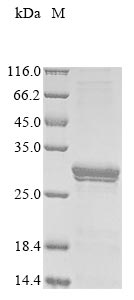Recombinant Mouse Protein canopy homolog 2 (Cnpy2) is produced in an E.coli expression system and contains the full length of the mature protein, spanning amino acids 21 to 182. This protein features an N-terminal 10xHis-tag and a C-terminal Myc-tag, which makes purification and detection more straightforward. With a purity level exceeding 85% as determined by SDS-PAGE, this product appears well-suited for various research applications requiring high-quality reagents.
Canopy homolog 2 (Cnpy2) is a protein involved in various cellular processes. It likely plays a significant role in the regulation of signaling pathways, though the exact mechanisms may still be under investigation. As a part of the canopy family, Cnpy2 is studied for its involvement in protein folding and cellular homeostasis. Its functional relevance and interactions make it a valuable subject in research focused on cellular signaling mechanisms.
Potential Applications
Note: The applications listed below are based on what we know about this protein's biological functions, published research, and experience from experts in the field. However, we haven't fully tested all of these applications ourselves yet. We'd recommend running some preliminary tests first to make sure they work for your specific research goals.
Mouse Cnpy2 is a eukaryotic protein that requires precise folding, proper tertiary structure, and potential post-translational modifications for its functional activity in cellular processes such as protein folding and quality control. The E. coli expression system cannot provide the eukaryotic folding environment, chaperones, or modifications that may be important for this protein. The dual N-terminal 10xHis-tag and C-terminal Myc-tag are relatively small compared to the protein size (162 aa, ~18 kDa) and may cause minimal steric interference. While the full-length mature protein (21-182aa) contains all functional domains, the probability of correct folding with functional bioactivity requires experimental validation due to the prokaryotic expression system.
1. Protein-Protein Interaction Studies Using Pull-Down Assays
This application carries a significant risk without functional validation. Cnpy2 interactions with partners require native conformation. If correctly folded and active (verified through binding assays), the protein may identify physiological interaction partners. If misfolded/unverified, there is a high risk of non-specific binding or tag-mediated artefacts, yielding biologically misleading results.
2. Antibody Development and Validation
This application is highly suitable as antibody development relies on antigenic sequence recognition rather than functional protein folding. The full-length mature protein provides comprehensive epitope coverage for generating Cnpy2-specific antibodies. The high purity (>85%) ensures minimal contamination-related issues during immunization.
3. Biochemical Characterization and Structural Studies
These studies are essential for determining folding status. Techniques should include circular dichroism spectroscopy to assess secondary structure, size-exclusion chromatography to evaluate oligomeric state, and thermal stability assays. However, if misfolded/unverified, results will describe an artificial construct rather than native Cnpy2.
4. ELISA Development for Quantitative Detection
This application carries risk without validation. ELISA assays require that the recombinant protein mimic native Cnpy2 for accurate quantification. If correctly folded and antigenically similar (verified), it can be used as a standard; if misfolded/unverified, assay results may not correlate with native protein levels.
Final Recommendation & Action Plan
The E. coli-expressed Cnpy2 with dual tags may not be properly folded for functional applications due to the lack of eukaryotic folding machinery. Begin with Application 3 (Biochemical Characterization) to assess folding quality through techniques like CD spectroscopy and SEC. Applications 1 and 4 require rigorous validation against native protein interactions or detection before use. Application 2 (antibody development) can proceed immediately. For reliable Cnpy2 research, validate folding and functionality using cell-based assays or compare with mammalian-expressed protein when possible.






